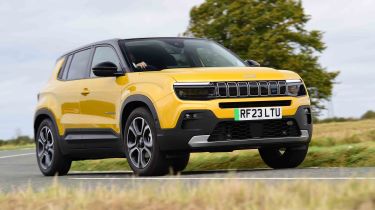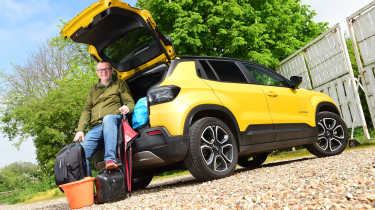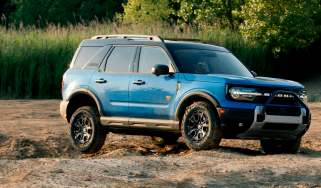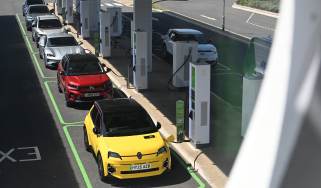Jeep Avenger review
Jeep’s handsome little Avenger SUV is available in petrol, hybrid and electric forms, but there are more practical rivals around

Our opinion on the Jeep Avenger
Whether you choose the Jeep Avenger in petrol or all-electric forms, you’ll get an enticing small SUV with hidden depths beyond its attractive exterior. We’ve no doubt that a few examples of Jeep’s little bundle of joy will be sold based solely on how it looks, but the Avenger boasts much better tech than any of the brand’s previous offerings we’ve tested so far, and the EV version offers a usable range.
Sure, it’s not the Jeep you’ll want for tackling the Appalachian trail, but it feels right at home in the hustle and bustle of packed city streets, and is decent to drive. The addition of petrol-powered models has also made the Avenger more accessible, not least by lowering the starting price. However, the limited space available for rear passengers will be a shortcoming that might rule this out for some potential buyers.
Key specs | |
| Fuel type | Petrol, mild-hybrid, electric |
| Body style | Small SUV |
| Powertrain | 1.2-litre, 3cyl, turbo, petrol, front-wheel drive 1.2-litre, 3cyl, turbo, petrol plus 1x e-motor, front-wheel drive 54kWh battery, 1x e-motor, front-wheel drive |
| Safety | 3-star (Euro NCAP, 2024) |
| Warranty | 3yrs |
About the Jeep Avenger
The Jeep Avenger is based on the same CMP/e-CMP platform, and can be fitted with a traditional petrol engine, a more efficient hybrid powerplant, or an electric motor.
Underneath the floor in the EV version lies a 54kWh battery pack that powers the single electric motor that drives the front wheels. Some die-hard Jeep fans may view this as sacrilegious, but a 4xe version with all-wheel drive is available, and with its various drive mode settings, it should be able to handle the odd muddy track.
The pure-petrol models feature a turbocharged 1.2-litre three-cylinder engine and six-speed manual gearbox, while a mild-hybrid setup powers the Avenger e-Hybrid. This combines a 1.2-litre petrol engine and a 28bhp electric motor powered by a small lithium-ion battery, with the electric motor integrated directly into the six-speed automatic gearbox. The e-Hybrid setup offers the ability to drive at low speeds on pure electric power, making it a more refined town car in the process.
The trim structure for the Avenger is pretty straightforward: petrol, e-Hybrid and electric models are available in Longitude, Altitude and Summit trim, while the 4xe version gets its own bespoke versions called Upland, Overland, and The North Face.
In order to provide at least some form of off-road capability that fits in with the brand’s heritage, all Avengers get several drive modes, including specific settings for Mud, Sand and Snow, as well as a hill descent system. These features enable this small SUV to handle at least some wet or slippery terrain if the occasion arises.
Entry-level Longitude models get 16-inch alloy wheels and automatic LED lights, a 10.25-inch central touchscreen with Apple CarPlay and Android Auto connectivity, a seven-inch digital driver’s display, rear parking sensors, cruise control and a handful of other safety systems.
Stepping up to Altitude adds a larger 10.25-inch digital dash, 17-inch wheels, keyless entry, adaptive cruise control, a 180-degree reversing camera, and an additional USB port in the rear. Top-spec Summit cars get 18-inch wheels, wireless phone charging, blind spot monitoring, and on automatic e-Hybrid and electric versions, level 2 autonomous driving tech.
The more off-road-worthy 4xe models start with Upland, which features dedicated mud and snow tyres, chunky front and rear bumpers, roof rails, rear tow hooks, and washable seat trim. Overland adds wireless phone charging, a 360-degree camera system, and blind spot monitoring. The top-of-the-range The Northface has a heated windscreen, heated front seats, an electric tailgate, sat-nav, and some black and gold exterior detailing.
If you're tempted to buy a Jeep Avenger, we are here to help. You can use our Find a Car service to configure your ideal Jeep Avenger and get the best offers from nearby dealers, check out top Jeep Avenger leasing deals or search for used Jeep Avenger models. Need to sell your current car? Cut out the hassle and get a great price by visiting our Sell My Car page.
Jeep Avenger prices and latest deals
Performance & driving experience
|
Pros |
|
| Cons |
|
In keeping with the brand’s off-road heritage, the Jeep Avenger rides higher than some of its closest rivals and offers generous ground clearance to clamber over obstacles. There’s good all-round visibility thanks to the raised ride height, and a squared-off bonnet makes it easy to place the car on the road.
The vast majority of the petrol, hybrid and electric range is front-wheel drive, and those who desire or require a proper 4x4 will have to opt for the hybrid-powered 4xe. Four-wheel drive is quite rare for the small SUV class, with only a tight-knit group of rivals such as the Lexus LBX and Toyota Yaris Cross offering the benefits of all-wheel traction for slippery conditions.
In addition to the usual Eco, Normal and Sport drive modes, there are Mud, Sand and Snow settings, along with a hill descent system. Our experiences have been limited to lightly rutted dusty tracks, but we’d wager the Avenger could show its SUV rivals a clean pair of heels over wet or slippery terrain..
Performance, 0-60mph acceleration and top speed
The pure-petrol Avenger uses a turbocharged 1.2-litre three-cylinder (also used in the Peugeot 2008 under the ‘PureTech’ badge) engine that produces 99bhp and 205Nm of torque, and is paired exclusively with a six-speed manual gearbox. The official 0-62mph time is 10.6 seconds, which may sound slow, but the petrol Avenger provides a decent amount of punch, and doesn’t need to be worked very hard when accelerating up to motorway speeds. However, this engine has very little inertia, losing revs quickly when you dip the clutch during gear changes, and making it hard to shift smoothly unless you do it slowly; rushing things causes the car to lurch. This also becomes an issue downhill, where engaging a lower gear doesn’t result in a lot of engine braking.
The Avenger e-Hybrid’s mild-hybrid powertrain combines a 1.2-litre petrol engine with a small electric motor and six-speed automatic gearbox, and makes the same 99bhp combined as the regular petrol version. The electric motor is integrated directly into the transmission, and is powered by a small lithium-ion battery to provide instant torque to the engine, which is useful when accelerating away from a stop. According to Jeep, its 0-62mph time takes 10.4 seconds, while its top speed is the same as the pure-petrol model at 114mph.
The all-electric version uses a single electric motor to drive the front wheels. It pumps out up to 154bhp and 260Nm, which is enough to propel the Avenger from 0-62mph in 9.6 seconds. In Normal mode, the little SUV accelerates at a leisurely pace, clearly not in a hurry to go anywhere. Switching to Sport mode unlocks the maximum power output and delivers a big hit of torque when you first put your foot down, but after that initial hit of performance, it feels much the same as its regular Normal driving mode. Either way, the electric motor feels punchy enough for most situations, especially when you’re in town. It’s only pulling onto motorway slip roads or when overtaking that the Avenger can feel a little short on shove.
The four-wheel drive 4xe, meanwhile, has 134bhp to play with. Thanks to this extra power compared to the regular petrol and mild-hybrid versions, this Avenger accelerates from 0-62mph in 9.5 seconds, before going on to a top speed of 121mph.
Town driving, visibility and parking
The Avenger does a good job of dealing with harsh potholes at low speeds, because the suspension soaks them up without too much crash into the cabin. We feel that the steering could do with a bit more weight and feel, but the upside of the light setup is that it makes the car super-easy to drive around town.
Although the least powerful petrol doesn’t look to offer the sort of shove off the line required to mix it with city traffic, in reality, it has a generous hit of low-down torque, so you can make it into gaps in the traffic without too much trouble. It could use a slicker six-speed gearbox, though, which isn’t as pleasant to use as the ones in the Ford Puma or Skoda Kamiq.
There is a brake regeneration system in the Avenger EV, but it isn’t strong enough to allow for one-pedal driving, which is a shame for a car so adept at city driving. In fact, it can be hard to discern when you’re driving in the regular ‘D’ mode, which allows the car to coast more, or the ‘B’ mode, which activates the regenerative braking, because its effects are so subtle.
B-road driving and handling
While the Avenger might be capable of dealing with potholes at low speeds, picking up the pace causes it to struggle compared to the Kamiq. It also lacks the body control of a Puma, and so the body of the Avenger leans more in corners. The little Jeep maintains a decent level of grip, but this isn’t the sort of car you drive quickly for fun.
This is also due to the steering, which isn’t brimming with feedback and seems a little vague around the straight-ahead position.
The Electric Avenger is responsive enough in its Normal mode to keep up with the flow of traffic on faster roads, but switching to its Sport setting sees throttle response become snappier, which takes a bit of getting used to. If you’re in Normal mode and need the extra power for an overtake, there’s an auto-style ‘kickdown’ in the pedal travel that unlocks maximum power.
Motorway driving and long-distance comfort
The Avenger provides decent comfort on longer journeys, with respectably low levels of wind and road noise for a small SUV. The regular petrol engine blends into the background, as does the EV version's electric motor. All versions feel stable at high speed, but the ride is a touch bumpier than rivals such as the Kamiq.
| Model | Power | 0-62mph | Top speed |
| 1.2 GSE 100 manual | 99bhp | 10.6s | 114mph |
| 1.2 e-Hybrid 136 4xe DCT6 auto | 134bhp | 9.5s | 121mph |
| Electric 156 auto | 154bhp | 9.6s | 93mph |
“Although 99bhp doesn’t sound like much, a generous hit of low-down torque from the Jeep’s 1.2-litre turbo engine provides more than enough performance for daily driving” - Alex Ingram, chief reviewer.
MPG & running costs
|
Pros |
|
| Cons |
|
The base 1.2-litre petrol Jeep Avenger is rated return up to 49.6mpg on the WLTP cycle. During our twin test between the petrol-powered Jeep Avenger and the Skoda Kamiq, the Avenger returned an average of 47mpg. This trumped the Skoda’s 45.3mpg, albeit only slightly.
The mild-hybrid Avenger e-Hybrid offers improved fuel efficiency over the pure-petrol model, with Jeep claiming it will return up to 57.1mpg. This version’s CO2 emissions are better when compared with the pure-petrol model: 111-114g/km compared with 127-130g/km.
Adding four-wheel drive to the 4xe’s mild-hybrid engine means it isn’t quite as efficient as the front-wheel drive e-Hybrid, but a WLTP figure of 52.3mpg isn’t bad, as is the 122g/km CO2 rating.
| Model | MPG | CO2 | Insurance group |
| 1.2 Altitude | 49.6mpg | 130g/km | 23E |
| E-AWD e-Hybrid Upland | 52.3mpg | 122g/km | 27E |
| 1.2 e-Hybrid Longitude 5dr DCT | 57.6mpg | 111g/km | 22E |
Electric range, battery life and charge time
The electric Jeep Avenger uses the same battery and motor technology that powers the updated versions of the DS 3 E-Tense and Peugeot E-2008, among others. Under the floor is a 54kWh battery, of which 51kWh is usable. Jeep says it can provide enough juice to cover up to 248 miles across a mixture of driving conditions. That’s less than cars such as the Hyundai Kona Electric, but still competitive for this size of electric SUV.
During our twin test between the Avenger EV and Mazda MX-30, the Jeep returned 4.3 miles per kWh, trumping the Mazda’s 3.6mi/kWh by quite some margin. We achieved that figure even after some long journeys on the motorway, so we expect to see even better numbers if you spend most of your time driving in town at low speeds. Either way, the Avenger EV comfortably provides 200 miles of range from a charge.
Speaking of which, the Jeeps’ charging speeds are also on par with most of its main rivals, but again, not class-leading. The Avenger’s 100kW maximum charging speed is still enough for a 20-80 per cent top-up in 24 minutes, though. Fully charging a flat battery at home using a typical 7.4kW home wallbox should take around seven and a half hours.
| Model | Battery size | Range | Insurance group |
| e-Altitude | 54kWh (51kWh useable) | 248 miles | 24E |
Insurance groups
The electric Jeep Avenger sits in insurance groups 24 or 25 (out of 50), depending on which trim level you go for. That means it attracts similar ratings to the Peugeot E-2008 (26 to 27), but it undercuts the Hyundai Kona Electric (31 to 33).
The petrol and hybrid models start in the ever so slightly more affordable group 23, but no version can quite match the low insurance group ratings of the Renault Captur, which starts in group 10, or the Skoda Kamiq in group 15.
Tax
For business users, the all-electric Avenger attracts the lowest Benefit-in-Kind (BIK) rates, but it is no longer exempt from Vehicle Excise Duty (VED) road tax. For those who don’t wish to go fully electric, the e-Hybrid 100 is the most economical and has the lowest emissions of the combustion-powered Avenger range.
No version of the Avenger costs over £40,000 when new, so it avoids falling into the luxury car tax band.
Depreciation
According to our latest expert data, the Jeep Avenger is expected to retain 39-44 per cent of its original value after three years of ownership, with 36,000 miles on the clock, when it comes time to trade in. The 4xe Upland is expected to retain the most value compared to the rest of the range.
Interior, design & technology
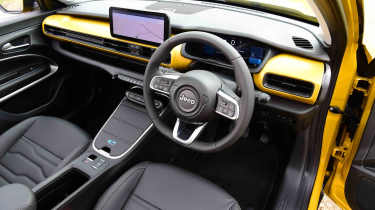
|
Pros |
|
| Cons |
|
The design team’s brief for the Avenger was to fit “100 per cent of the brand DNA into four metres”, and frankly, they nailed it – even from 100 feet away, you know this is a Jeep. While other small SUVs feature curvaceous bodywork or a swooping roofline to look futuristic or help with aerodynamics, the Avenger has an unashamedly chunky and squared-off shape with a broad, planted-looking stance to give it more attitude.
At the front is an evolution of Jeep’s iconic seven-slot grille, and overall, the Avenger does have a slightly aggressive face. But because of just how small it is, it reminds us of a puppy that enjoys growling at the postman in the morning.
There’s extensive cladding along the side of the car and the wheel arches, which gives it the essence of a rugged off-roader and has the additional benefit of being more resistant to knocks and scuffs. The rear is simple, with more black plastic and tail lights with an X-shaped motif.
Jeep has also hidden numerous ‘easter eggs’ around the Avenger, including seven-slot-grille motifs on the rims and front air intake, as well as a small illustration of the designer's son looking through a telescope at the stars in the corner of the windshield.
There are many paint colours for buyers to choose from, including two-tone schemes like Sun yellow and a Volcano black roof. Opting for this particular combo also gives you the option of a yellow dashboard, which brightens up the cabin. However, you have to go for top-spec Summit trim to unlock this option, which is a shame because we bet many customers would pay to inject a bit more colour into the already quite funky cabin.
Thankfully, Jeep offers plenty of other accessories to help distinguish your Avenger from the rest, including graphics for the bonnet and grille, 18-inch wheels with blue accents, and the usual assortment of roof racks and rubber mats for the boot and footwells for more outdoorsy owners who don’t want to track mud into the carpets.
Avenger 4xe buyers are able to stand out a little more thanks to unique bumpers and alloy wheels. Opting for The North Face trim also brings branded exterior decals, gold highlighting both inside and out, an exclusively designed dashboard and specially embroidered seats.
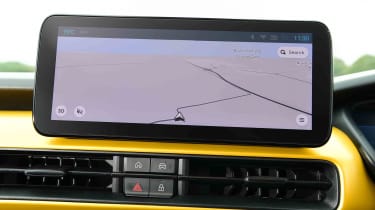
Interior and dashboard design
Inside, the cabin uses chunky toggle buttons on the dashboard, and a number of big buttons on the steering wheel and centre console. We’re not too fond of the interior light controls on the roof, though, because the unit looks like it came from the decade-old Fiat Panda.
While we approve of the use of physical buttons in the Avenger to control frequently used features, such as the climate control, we prefer the simpler dial set-up used in the Kamiq. However, making small adjustments in the Avenger is still less distracting compared to the Puma, which has gone all in on touchscreen controls.
Materials and build quality
The swathes of hard plastic inside the Avenger may be rugged and reasonably hard-wearing, but it lacks the premium feel of something like the Skoda Kamiq, which uses more soft touch materials, has controls that emit a satisfying click, and buttons that have the typical Volkswagen feel of being well damped.
Infotainment, sat-nav and stereo
The Avenger’s infotainment system is a significant improvement on older Jeep tech. The larger 10.25-inch screen we’ve tried so far is a good size, and it’s responsive. Standard-fit wireless Apple CarPlay and Android Auto ensure buyers can utilise apps from their phones. There’s a large storage cubby that lives below a row of climate controls, and a proper volume dial for the audio system. There are physical ‘home’ and ‘settings’ buttons located just below the touchscreen; however, they’re small and not illuminated, so it may take a while to develop the muscle memory required to find these at night.
“The Jeep’s smart exterior looks are matched by its cabin, which is well designed and has plenty of character. It’s only really let down by some hard, cheap-looking plastics in a few areas – the fake wood grain that spans the dash is unconvincing – but overall the Jeep’s dash looks interesting.” - Alex Ingram, chief reviewer.
Boot space & practicality
Pros |
Cons |
|
|
Jeep claims there are 34 litres of storage in the front of the Avenger’s cabin – enough, apparently, to stash the contents of a carry-on suitcase among its various cubbies. The one below the central infotainment screen is handy and is accessed via a tablet-style magnetic cover on certain models. It’s deep, and in top-spec cars, hides a useful wireless phone charger large enough to accommodate even the biggest of smartphones.
There’s also a handy shelf in the dashboard for your passenger’s phone, or perhaps to keep your wallet and keys in sight. The centre console features movable dividers that can serve as cup holders, with even more storage space in a deep cubby beneath the armrest. The front door bins are on the thin side, though, and there aren’t any in the rear. There’s also just one USB-C charging port in the back, so kids might have to squabble over who charges up their tablet on longer journeys.
| Dimensions | |
| Length | 4,084mm |
| Width | 1,776mm 1,981mm (inc mirrors) |
| Height | 1,536mm |
| Number of seats | 5 |
| Boot space | 321-1,277 litres (petrol) 282-1,252 litres (electric) 262-1,218 litres (4xe) |
Dimensions and size
At 4,084mm long, 1,776mm wide and 1,528mm tall, the Avenger is a very compact car – one of the smallest in its class, in fact. It’s 126mm shorter than a Nissan Juke, and 216mm shorter than the Peugeot 2008, despite sharing that car’s basic platform. The Avenger’s only 24mm longer than a Vauxhall Corsa supermini, though its compact dimensions make it adept at navigating tight city streets.
Driving position, seats & space in the front
Visibility is good from the driving seat, and the squared-off bonnet makes the car easy to place on the road. Its boxy shape also allows for an impressive amount of headroom up front, with enough shoulder room for a pair of adults over six feet tall.
The seats are comfortable, with decent side bolsters, so you don’t feel like you’ll slide out of them through the corners. Even drivers who are six feet tall or above should have no problem finding a comfortable driving position thanks to lots of adjustment in both the seat and steering wheel.

Seats & space in the back
However, rear legroom is somewhat on the tight side, and if the driver is tall, there’s only enough room in the back for small kids. With someone smaller in stature at the wheel, and the front seats a little further forward, you might just be able to accommodate two adults at a push, but we doubt the Avenger can seat five as Jeep has claimed. However, we like that the backs of the front seats are squishy, so rear passengers’ legs aren’t crushed against hard plastic if they need to squeeze in.
There are three sets of ISOFIX mounting points in the Avenger – one on the front passenger seat and the remaining two on the outer positions of the rear seats. However, the small rear door openings could make installing a child seat a little trickier than in some rivals.
Boot space
The Avenger offers 321 litres of space (282 litres in the electric version and 262 litres in the 4xe), which is slightly larger than a Vauxhall Corsa supermini, but somewhat shy of family hatchbacks like the Volkswagen Golf.
However, the one-metre-wide opening and nice square shape of the load bay also boost practicality, while folding the rear seats down gives you a total of 1,277 litres (1,252 litres in the electric version and 1,218 in the 4xe) of space to play with. There’s no ‘frunk’ or storage under the bonnet of the EV like you get in a Hyundai Kona Electric, but there’s enough space under the boot floor to keep the charging cable out of sight.
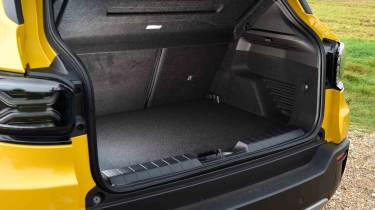
Towing
Those who need to lug a trailer or caravan will have to avoid the electric Avenger because this isn’t rated to tow. Instead, the pure-petrol model is the best choice due to a towing capacity of up to 1,200kg. The front-wheel drive hybrid isn’t far behind with a maximum 1,100kg, but the four-wheel drive 4xe only manages 920kg.
“The Jeep is barely any longer than a supermini on the outside, and that’s reflected in its interior cabin space, which lags behind the Skoda Kamiq. A 157mm difference in overall length between these two – 94mm of which is within the wheelbase – really shows in the back of the Avenger, where it has significantly less room for passengers.” - Alex Ingram, chief reviewer.
Reliability & safety
|
Pros |
|
| Cons |
|
The Jeep Avenger received a disappointing three stars out of a possible five from safety experts Euro NCAP when put through the updated test in 2024. That’s a shame when one of our favourite small SUVs, the Renault Captur, gets four stars.
The Avenger was criticised for not having a central airbag between the front seat occupants to protect them from striking each other in a side impact, and not having a rear child presence detection system. There were also concerns about the pressure on the chests of rear seat occupants in a head-on crash and the lack of an effective system for detecting vulnerable road users.
In terms of safety kit, every Avenger is equipped with six airbags, ISOFIX on the front passenger and rear seats, cruise control, lane departure warning, traffic sign recognition, drowsy driver detection, traction control and rear parking sensors. Mid-range Altitude-spec models add adaptive cruise control, a 180-degree rear-view camera, and automatic high/low beam, while range-topping Summit cars feature blind spot monitoring and, on automatic models (e-Hybrid and electric), lane centring and traffic jam assist.
The Avenger is yet to appear in our Driver Power owner satisfaction survey, but there is some hopeful news: the Vauxhall Mokka (which shares several components with the Jeep) came in 18th place overall out of 50 cars, which is a respectable result, and goes at least some way towards proving the dependability of the Jeep’s underpinnings. The Jeep brand still has work to do, coming in 26th out of 31 brands, above VW (27th), Cupra (28th), and MG (31st), but below Kia (18th) and Renault (6th).
| Key standard safety features |
|
| Euro NCAP safety ratings |
|
Buying and owning
Our best buy: Jeep Avenger Electric Altitude
It’s not the cheapest variant to buy, but the electric Jeep Avenger offers some of the lowest running costs, as well as some big tax savings for company car users. Being able to cover over 200 miles on a single charge should prove plenty for most daily needs, and this is easily one of the easiest SUVs to drive in and around town.
The e-Hybrid, while more efficient than the petrol, adds a not inconsiderable price premium over its cheaper brethren, which we don’t think is worthwhile in the end. The same goes for the 4xe, which doesn’t really have the ground clearance to justify it as an off-road vehicle.
The mid-range Altitude trim offers some useful added luxuries, including adaptive cruise control, and a reversing camera. It features synthetic leather on the steering wheel, a significant upgrade from the plastic used in the base model.
Jeep Avenger alternatives
With a choice of petrol, hybrid and electric power, the Jeep Avenger has to compete with a vast array of small SUVs.
Those include the best-selling Ford Puma, Renault Captur, Nissan Juke and Volkswagen T-Cross, plus smaller electric SUVs like the Smart #1, Kia Niro EV, Peugeot E-2008 and Hyundai Kona Electric.
Due to its compact size and agility, the Avenger also poses a threat to style-focused zero-emission city cars like the Fiat 500e and MINI Cooper.
Latest deals on the Avenger and rivals
Jeep Avenger Summit long-term test
Former Editor-at-large, John McIlroy, ran a top-spec Jeep Avenger Summit for six months as part of the Auto Express long-term fleet. During his time with this baby electric SUV, he felt that it had the character of a proper ‘all-American’ Jeep, even though it was designed for the European market. He was a fan of the chunky styling, and the Jeep even lived up to its badge as it proved reasonably capable at off-roading.
John believed that the Avenger felt precisely like a small Jeep should, although perhaps a little more rear leg room and a slightly bigger boot would be useful improvements in the future, given his family had to use some ingenuity when packing for a family holiday. You can read the full long-term test here…
Jeep Avenger pictures
Frequently Asked Questions
The Jeep Avenger is a charming small SUV that looks rugged and comes with quite a lot of kit, while the all-electric version offers a 248-mile range and is a breeze to drive around town.
New & used Jeep Avenger deals
